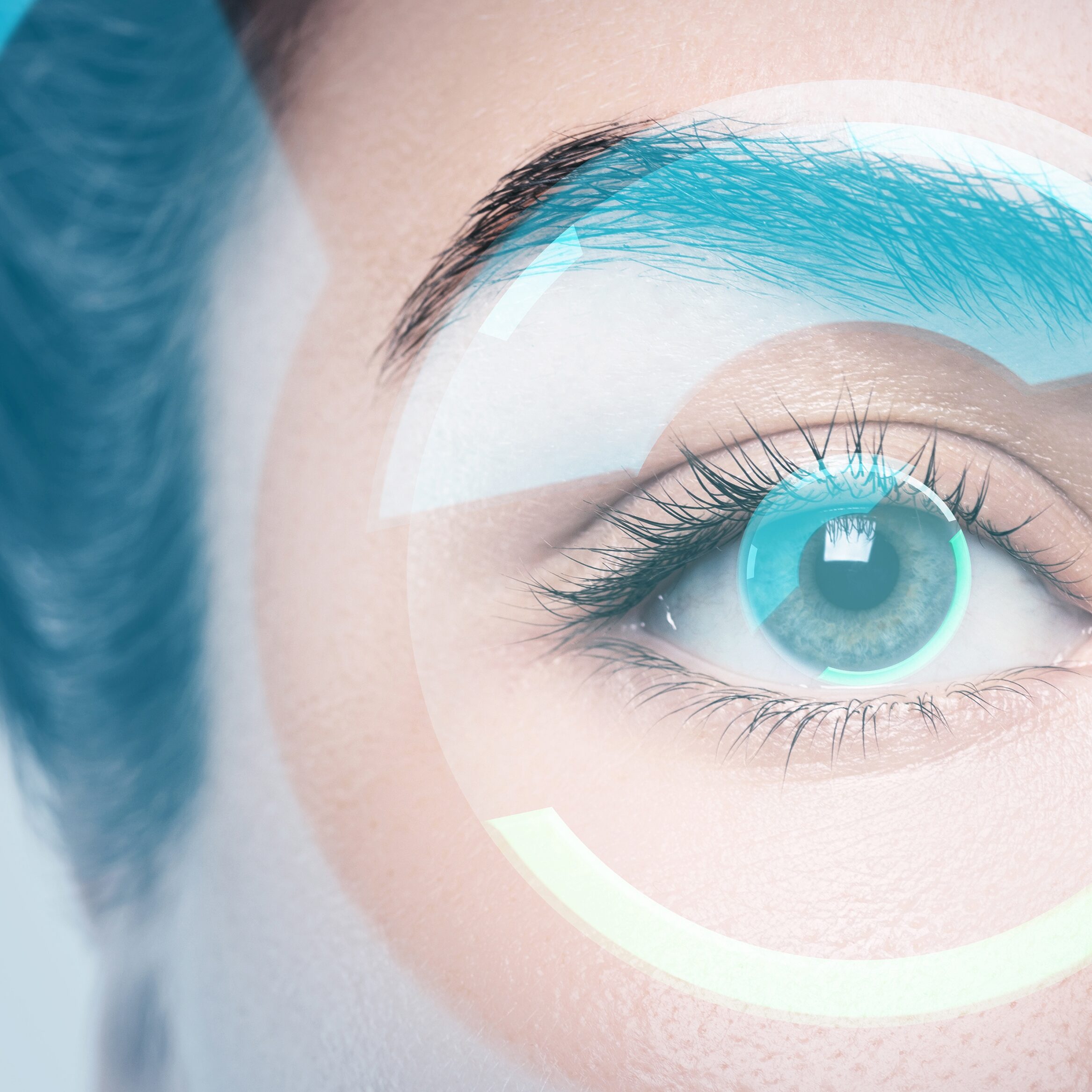2002年
ドイツ、{MQ}ヨーロッパ、アジア、アメリカ、中国での講演と科学的研究
2003年
韓国・ソウル中央大学校 眼科 白内障・屈折矯正手術科 教授
2004年
ASCRS(米国白内障屈折矯正外科学会)討論者
2017年
上海新視眼科病院
2020年
アウレジオ・デイ・クリニック・デュッセルドルフ
これまでの受賞歴
- ASCRS(米国白内障屈折矯正手術学会):学会最優秀発表/講演、ケト屈折老視:レーザーベース:
2010年
- ASCRS(米国白内障屈折矯正手術学会):学会最優秀ポスター/イラストレーション、ケト屈折老視:眼内手術:2010年
健康な目
角膜(透明な角膜)は目の外殻の一部です。
その奥には虹彩(カラーアイリス)があります。
目の中心には瞳孔があり、丸い開口部として見え、その奥に透明な水晶体があるのです。
網膜は目の内層を形成します。
鋭い視力
目はカメラのような仕組みです。光は角膜から目に入り、レンズを通過し、焦点が合っている目の網膜の正確な中心にある網膜に当たります。
瞳孔は、それに応じて拡大または縮小することにより、常に適切な量の光が目に入るようにしているのです。
水晶体を平らにしたり膨らませたりすることで、近くの物体と遠くの物体のどちらが目で認識されるかに応じて、鮮明な画像が形成されます。
網膜はカメラのフィルムに相当するものです。
光線はレンズから網膜に投影されます。
脳は網膜の光受容体を介して情報を受け取り、そこで画像が最終的に形になるのです。
近視の形態
PRKはレーザー眼科手術で最も古い手術です(1987年発祥)。
最大-8ジオプターまでの近視、最大+3ジオプターまでの遠視、最大-6ジオプターの乱視の矯正に適しています。
まず、角膜の最上層である上皮を機械的またはレーザー(トランスPRK)で除去します。
その後、角膜の中心部をエキシマレーザーで切除し、屈折異常を補正します。
手術の最後には、特別な漏斗を使って角膜を冷却します。
コンタクトレンズの下では数日で上皮が再形成され、表面の傷口を閉じます。
PRK、LASEK、トランスPRKは基本的に同じ仕組みです。
慎重かつ包括的な予備検査の目的は、予見可能なリスクをすべて排除. このようにして、当院では患者様がレーザー治療に適しているかどうかを判断します。
この方法は数十年にわたって何百万回も実践されており、科学的に認められたレーザー治療であり、長期的に非常に安定した結果が得られます。
どちらの方法でも関連するリスクは低いです。
予備検査の結果の一部が陰性の場合は、レーザー手術を受けないよう患者様に推奨します。
代替方法
この施術では、小さな切開部から人工水晶体を眼内に挿入し、天然水晶体と虹彩の間に埋め込みます。
このレンズでは、-20ジオプターまでの近視、最大+10ジオプターの遠視、最大-6ジオプターの乱視を矯正します。
他の水晶体手術では、レンズを虹彩に取り付けるか、自然水晶体の前のチャンバーアングルにレンズを取り付けます。
屈折矯正レンズ交換(RLE)またはクリアレンズ交換(CLE)とも呼ばれる屈折矯正レンズ交換では、眼の自然なレンズを取り除き、多焦点レンズまたは収容力のある人工レンズと交換します。
この施術は、最大-30ジオプターまでの近視、最大+20ジオプターまでの遠視、および約-12ジオプターまでの乱視の矯正に適しています。
手術内容は、医学で最も一般的な外科手術である白内障手術と同じです。
したがって、標準化され、極めて安全とされています。
白内障手術との違いは、水晶体はまだ比較的透明ですが機能不全であり、老眼だけでなく既存の欠陥を補うために交換されることです。
この施術は、従来のようにブレードと超音波装置を使用して実行できます。
フェムトセカンドレーザーを使った手術は、より優しく正確です。
この高度な処置により、人工レンズの最適な固定とセンタリングが保証されます。
治癒が完了した後(3~6ヶ月)、乱視や収差などの屈折異常が残っている場合は、エキシマレーザーで矯正することができます。
LASEKと水晶体手術を組み合わせた眼科手術法は、BIOPTIKとも呼ばれます。
屈折矯正レンズ交換(RLA)は、老眼鏡や遠近両用メガネを不要にするための、今のところ最も信頼できる最善の手術方法です。
SUPRACOR手術は、レーザー眼科手術の世界的権威であるテクノラス・パーフェクトビジョン社によって開発されました。
SUPRACORレーザー治療により、AUREGIOレーザーセンターは、LASEKと組み合わせたエキシマレーザで老眼を治療する最先端の可能性を提供しています。
SUPRACORレーザーの施術を受けることで、将来、眼鏡をかけなくても生活を送ることができます。
Supracorでは、遠方視力と近方視力について、両眼の角膜を同じように治療します。
これが多焦点治療と言われる所以です。
目のレーザー治療の質、ひいては治療の安全性、ひいては生涯にわたる視力の質は、使用する技術と外科医の経験に決定的に依存します。
*/85followingでは、いくつかの的を絞った質問に基づいて、安心して手術を受けられるところと、一見すると安価かもしれないものの、時代遅れの技術に「価格的な優位性」を求める劣悪な治療法を見分けるのに役立つチェックリストをまとめました。
治療成功の基礎は、良心的で綿密な目の検査によって築かれます。
これらの結果に基づき、患者様のニーズと要求を満たすことができる適切な処置が、詳細な話し合いの元で決定され、すべてのリスクと可能性がオープンに議論されます。
虹彩認証システム(将来のバイオメトリックパスポートデータに基づく虹彩写真)が患者の識別に使用されます。
虹彩が記録された対応する予備検査が割り当てられ、個別の治療が開始され、保証されます。
安全上の利点は、患者も目も混乱しないところです。
虹彩認証システム(将来のバイオメトリックパスポートデータに基づく虹彩写真)が患者の識別に使用されます。 虹彩が記録された対応する予備検査が割り当てられ、個別の治療が開始され、保証されます。
安全上の利点は、患者も目も混乱しないところです。
夕暮れ時や暗闇でよく見えるようにするには、治療部位が少なくとも夕暮れ時の瞳孔径と同じ大きさでなければなりません。
たとえ疑いがなかったとしても、夜間の条件下で正確に測定すると、患者は瞳孔が大きいことが多いのが現状です。そのため、旧式の装置によるレーザー治療では、夜間運転に問題(ハローなど)が生じる可能性があります 。
20年以上の経験と40,000件以上のLASEK症例数を持つスヴェン・リー医師が、高いレベルの専門性、精度、信頼性を保証します。
同じ医師による診察、予備検査、手術は極めて重要な要素です。
手術の基準は、すべての既知のガイドライン(特に屈折矯正手術委員会の品質保証)を考慮して定期的に管理されています。
スヴェン・リー医師にとって、患者様の健康と手術の質は最優先事項です。


MitoEnergy-Infusion zur Regeneration der Mitochondrien
Mitochondrien sind die Kraftwerke aller Lebewesen und produzieren unablässig Energie in Form von Adenosintriphosphat (ATP). Mitochondrien erfüllen viele lebenswichtige Funktionen für die Zelle. Dafür benötigen sie neben Sauerstoff auch Glukose, Aminosäuren, Fettsäuren, Mineralien, Vitamine und Nukleinsäuren.
Der Dysfunktion von Mitochondrien entgegenwirken
Wissenschaftliche Erkenntnisse belegen seit einigen Jahren, dass neurologische, metabolische, kardiale, immunologische und onkologische Erkrankungen immer häufiger mit einer erworbenen Dysfunktion der Mitochondrien als eine wesentliche Ursache in Verbindung stehen. Insbesondere die stark energieabhängigen Gewebe wie das Nervensystem, das Herz und die Muskulatur sind auf eine ausreichende Energieversorgung durch die Mitochondrien angewiesen. Eine erworbene Dysfunktion von Mitochondrien ist heutzutage laborchemisch sicher zu bestimmen.
Was beinhaltet und bewirkt die MitoEnergyBasis-Infusion?
Ziel der Behandlung ist die Regeneration der Mitochondrien, die sogenannte mitochondriale Biogenese: die Aktivierung und Neubildung von Mitochondrien. Wir nutzen dafür die MitoEnergyBasis-Infusion nach Rezeptur der Arnika-Apotheke in Unterhaching. Diese Rezeptur enthält in hohen Konzentrationen Vitamin C, reduziertes Glutathion, Carnosin, Magnesium, L-Arginin, Taurin, Glycin, Lysin, N-Acetyl-Tyrosin, Kalium-Magnesium-Aspartat, Vitamin B1, B2, B3, B5, B6, Adenosylcobalamin, Hydroxycobalamin und Methylcobalamin.
All diese Substanzen haben eine synergistische Wirkung auf die Funktion der Mitochondrien. Die störungsfreie Funktion ist nicht nur wichtig für die Produktion von Energie, sondern auch essenziell für die endogene Entgiftung sowie für immunologische Vorgänge. Die Infusionen werden gleichzeitig mit der me2.vie-Systemtherapie verabreicht. Hochfrequente Reizströme haben auf die Zell- und mitochondrialen Membranstrukturen einen positiven Einfluss und verbessern messbar die Versorgung der Mitochondrien mit den Nährstoffen.
Oculightの診療所で個別予約をして、{MQ}どの治療が視力を改善できるかを理解しましょう。

当院の診療内容、設備、治療法について詳しくお知りになりたい場合は、Eメール、WhatsAppメッセージ、お電話、またはお問い合わせフォームをご利用ください。